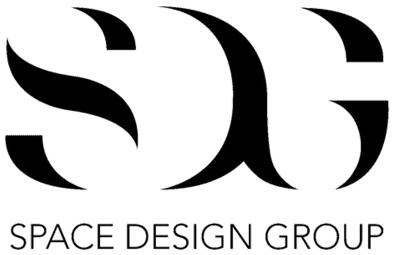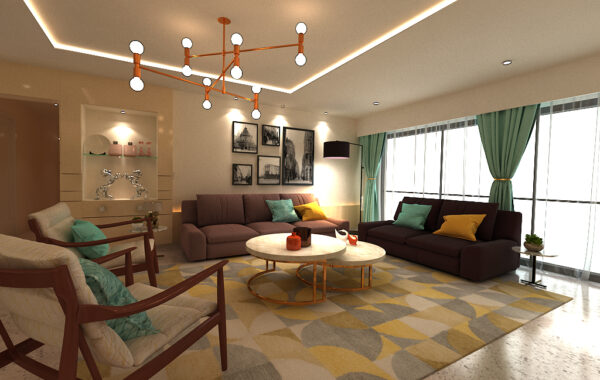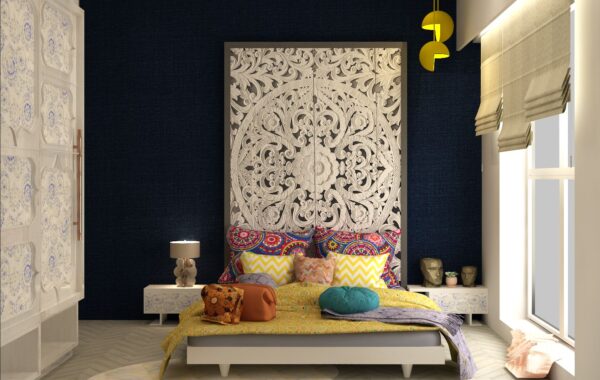When you walk into a room, your body instantly starts scanning—subconsciously evaluating safety, comfort, and flow. Surprisingly, one of the strongest signals your brain reacts to isn’t color, light, or furniture. It’s shape—specifically, whether a space is dominated by corners or curves.
As a world-class interior designer and behavior-minded creative, I’ve come to realize that geometry isn’t just aesthetic. It’s psychological. The way you shape a room directly impacts how people feel, think, and behave inside it.
Let’s explore the subtle but powerful psychological effects of corners and curves in interiors—and how you can design with geometry to enhance well-being, focus, and emotional flow.

🧠 Hardwired Reactions: Why Shape Matters to the Brain
From a neuroscience perspective, humans are wired to react quickly to environmental cues. Sharp angles and hard edges are often perceived as threatening or alerting, triggering subtle stress responses. Soft curves, on the other hand, signal safety, comfort, and approachability.
This dates back to evolutionary biology. In nature, sharp edges were rare and often associated with danger—thorns, cliffs, teeth. Rounded forms, like rolling hills or the human body, were familiar and non-threatening.
Your home may not be a jungle, but your brain doesn’t know that. It still responds to shapes as if survival depends on them.
⬛ Corners: Clarity, Control, and Cognitive Precision
Straight lines, rectangles, and corners are a staple of modern architecture—and for good reason. They suggest order, control, and direction. In spaces where structure, logic, and clarity are needed, corners excel.
When Corners Work:
- Home offices or study areas: Sharp geometry supports focus and task-oriented thinking.
- Kitchens: Right angles support efficient layout, maximizing usable surface and storage.
- Modern, minimalist aesthetics: Corners communicate intention and discipline.
Corners also create boundaries—visual and spatial. They tell the brain where things start and end, making them useful in organizing zones or functions within a room.
Psychological Associations of Corners:
- Structure
- Logic
- Authority
- Productivity
- Direction
But there’s a downside: too many hard lines can create tension. In relaxation zones, this may lead to subtle unease or restlessness.
🌀 Curves: Comfort, Connection, and Emotional Ease
Curved elements—arches, round tables, organic-shaped furniture—are the visual equivalent of a deep exhale. They soften a space, promote psychological safety, and encourage connection.
Where Curves Shine:
- Living rooms and lounges: Round shapes invite conversation and flow.
- Bedrooms: Arched headboards or circular mirrors soothe and soften.
- Children’s spaces: Rounded edges reduce physical danger and visual overwhelm.
Curves also help redirect energy. In feng shui and biophilic design, curves allow energy (or “chi”) to move gently through a space, preventing stagnation or abrupt energetic halts.
Psychological Associations of Curves:
- Calm
- Creativity
- Warmth
- Femininity
- Inclusivity
Too many curves, however, can sometimes lack direction or feel overly casual in task-driven spaces.
⚖️ The Balance: Mixing Geometry with Purpose
Great design isn’t about choosing corners or curves—it’s about curating the right balance based on function and feeling.
Combine Both Strategically:
- Use a rectangular desk for focused work—but add a rounded chair for comfort.
- Frame a room with linear architecture, then layer in circular coffee tables or soft lighting.
- Pair arched doorways with structured bookshelves for harmony between emotion and clarity.
A mix of curves and corners gives your brain both the definition it craves and the comfort it needs.
🪑 Furniture Forms: How Shape Directs Behavior
Furniture plays a crucial role in how we feel inside a room—especially its geometry.
- Square dining tables emphasize formality and hierarchy.
- Round dining tables encourage equality and conversation.
- Angular sofas suggest independence and posture; curved sectionals invite coziness and closeness.
Even your choice of lighting (sharp pendant vs. dome shade) can nudge people toward different moods—focus vs. ease.
Design Tip:
Before choosing a shape, ask:
“What kind of behavior do I want to encourage here?”
Then let form follow intention.
🧘 Corners vs. Curves and Mental Health
Environments designed for mental health—such as wellness centers, therapy spaces, or meditation rooms—often favor curves. The reason is simple: soft forms reduce the body’s fight-or-flight response. They invite openness, slow the heart rate, and soothe overstimulation.
Meanwhile, sharp lines, when overused, can subtly raise cortisol levels or maintain alertness—helpful for performance, but tiring over time.
In a post-pandemic world where home is everything—workplace, refuge, gym, studio—understanding the role of geometry in emotional regulation is more important than ever.
✨ Final Thought: Shape Your Space, Shape Your Mind
Interior design is never neutral. It always communicates—whether you mean it to or not.
Corners speak of precision, power, and action.
Curves whisper of comfort, softness, and connection.
When you begin designing with geometry in mind, you stop decorating and start directing behavior. You build spaces that are emotionally fluent—able to sharpen your mind when needed and soften your soul when it matters most.
So whether you’re styling a home office, a bedroom, or a communal space—pause to ask:
“Do I need clarity, or comfort?
Discipline, or flow?
Boundaries, or openness?”
Then pick your geometry—and let your space speak the right language.


